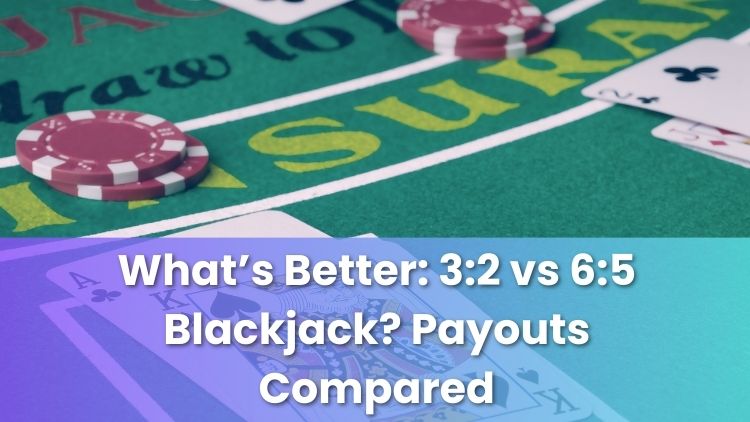
Choosing between 3:2 and 6:5 blackjack is something most people encounter sooner or later. The numbers might look minor, but they directly alter what a winning blackjack pays.
This blog post breaks down what those ratios mean, how they change returns, and which tables tend to offer stronger value across many hands. It also explores when 6:5 might still appeal and what to weigh up before sitting down.
Read on to learn more.
What Do 3:2 and 6:5 Blackjack Payouts Mean?
The terms 3:2 and 6:5 refer to what happens when the best starting hand in blackjack appears. This is a natural blackjack—when the first two cards total 21, usually an ace with a ten-value card.
With a 3:2 payout, a win here returns more than the stake. A 6:5 payout also adds extra, but not as much. For example, with £10 staked, one version gives £15 back, while the other gives £12.
That difference might seem modest for a single round—but over time, the effect is noticeable. The key lies in how often that hand appears and how much extra it gives each time.
Why Does the Blackjack Payout Ratio Matter?
These hands aren't rare. They come up regularly—roughly once every 20 rounds, give or take, depending on the number of decks and the rules in use.
When one version pays a little more for each of these hands, it adds up steadily. For instance, a 3:2 payout provides an additional 0.3 times the stake compared to 6:5 whenever a natural blackjack is dealt.
Multiply that across dozens—or hundreds—of hands, and the difference becomes far from trivial. Over time, this small detail starts to shape the overall performance of the table.
3:2 Blackjack Payout Explained
The 3:2 payout gives one and a half times the wager back on a blackjack. Bet £10, get £15. Bet £20, receive £30. All other wins and pushes follow the standard rules for the table, but this particular payout boosts returns on the strongest opening hand.
This has traditionally been the standard on many classic tables. It provides a higher return in a way that influences how the game performs across extended play. When other rules are fairly balanced, this version tends to preserve more value over the course of a session.
So, what happens when this is swapped out for the other common payout?
6:5 Blackjack Payout Explained
A 6:5 payout returns 1.2 times the wager on a blackjack. A £10 stake pays £12. A £20 stake returns £24. The mechanics of the hand stay the same—wins still win, pushes still push—but the highlight is that each blackjack is worth less than at 3:2.
You’ll often see this payout on tables with other tweaks—sometimes it’s a single-deck layout, or there may be lower betting minimums. These differences can appeal to some players, particularly for shorter or more casual sessions. However, that reduced return quietly shapes how the game plays out.
How Do the Payouts Change Your Winnings?
To see the impact clearly, let’s say a player hypothetically bets £10 a hand. A blackjack at 3:2 pays £15; at 6:5 it pays £12. That’s a £3 difference every time it comes up.
Now factor in how often blackjacks are dealt—around 4.8% of hands. Across 200 hands, that £3 difference would show up about 9 to 10 times, amounting to roughly £28 to £30 less returned at 6:5 than at 3:2, assuming everything else is equal.
Increase or decrease the stake, and the effect scales. It’s not just about one win, but how that win performs repeatedly. Over the course of a session, that single payout line on the felt can tilt results more than many players realise.
Which Blackjack Version Offers Better Value?
If the aim is to get more back from strong hands and keep the numbers working in your favour, 3:2 almost always outpaces 6:5. The reason lies in that extra return each time the best hand appears.
Other table rules still affect the outcome. Whether the dealer stands on soft 17, how many decks are in play, and whether splitting or surrendering is allowed all have their place. Still, the change from 3:2 to 6:5 shifts the edge by around 1.4 percentage points—enough to outweigh most small rule improvements.
If two tables look similar except for the payout ratio, the 3:2 table typically provides more reliable returns.
Is 6:5 Blackjack Worth Playing?
It might be—depending on what you're looking for. Some players choose 6:5 tables because they’re often easier to find, have lower stakes, or offer a format they enjoy. If the priority is a fast-paced, lower-cost experience and the setup feels comfortable, it can serve its purpose.
Still, even versions with seemingly appealing features—like single-deck layouts—usually don’t make up for the lower blackjack return. For anyone who wants stronger value from each hand, 3:2 tends to remain the preferred option when available.
House Edge Differences Between 3:2 and 6:5 Blackjack
The house edge is a built-in percentage that favours the casino. In well-balanced 3:2 games, that number often hovers near 0.5%, assuming optimal basic strategy is followed and rules are standard.
Switching the payout to 6:5 increases that edge significantly—by about 1.4%. A game that was sitting at 0.5% might now sit at 1.9% or higher, simply because blackjacks return less when they appear.
Since those hands occur regularly, the reduced return has a steady and measurable effect. For players looking to retain more value across sessions, watching for that 3:2 sign on the table layout can make a clear difference. It’s a small detail that carries weight with every round played.
*All values (Bet Levels, Maximum Wins, etc.) mentioned in relation to this game are subject to change at any time. Game features mentioned may not be available in some jurisdictions.
**The information provided in this blog is intended for educational purposes and should not be construed as betting advice or a guarantee of success. Always gamble responsibly.
